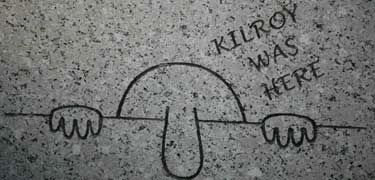How 'Kilroy Was Here' Changed the World

Each Monday, this column turns a page in history to explore the discoveries, events and people that continue to affect the history being made today.
Long before the Internet made viral marketing a cinch, one long-nosed little character named Kilroy made his way around the world the old-fashioned way, becoming a legend among the millions of military men and women who served during World War II.
The rudimentary doodle, which featured a balding head peering over a wall along with the tag "Kilroy Was Here," popped up in unexpected places across all of the theaters of war visited by American troops.
While competitions to inscribe the graffiti in obscure locations kept the battle-weary soldiers busy and its appearances kept them inspired, the mysterious Kilroy character had Japanese intelligence officers and even Hitler himself worried over the seemingly ubiquitous guy.
Reportedly spurred by an American dockworker, the "Kilroy Was Here" fad was an iconic part of World War II and 1940s lore.
The riveter that launched a thousand ships
The origins of "Kilroy Was Here" remain murky and clouded by urban legend, but the most credible source of the saying comes from a shipyard in Quincy, Massachusetts, most historians agree.
Sign up for the Live Science daily newsletter now
Get the world’s most fascinating discoveries delivered straight to your inbox.
On top of their military contribution overseas during World War II, the United States was heavily involved in the war effort producing ships, tanks, planes and weapons for the Allied Forces at plants across the country.
At one of the country's most prolific shipyards in Quincy worked James J. Kilroy — a rivet inspector who, like everyone in his trade, was paid by the number of rivets he checked and recorded his day's work on the machinery itself with a chalk mark. To avoid having his marks erased and moved by unscrupulous workers continuing his line of rivets, Kilroy began inscribing "Kilroy Was Here" on the machinery, historians say.
The dire need for ships overseas meant that most were launched into action before the workers' marks, including Kilroy's, were painted over or covered up.
American GIs began noticing the puzzling phrase scrawled on outgoing ships almost immediately, often tucked into hard-to-reach spots. At first, sailors treated an appearance of "Kilroy Was Here" like a kind of talisman, certifying that their ship had been properly checked and would be protected against the enemy. GIs later adopted Kilroy's standard and began tagging the places they'd visited across Europe, Asia and Africa.
The Kilroy character — just eyes and fingers visible from behind a wall or fence — was attached to the saying sometime early in the war.
Kilroy on the Moon?
By the end of World War II, "Kilroy Was Here" had achieved cult-like status, springing up in the unlikeliest of places — probably as a result of some friendly competition among GIs, historians believe — including some top-secret military installations. Latrines in France, beaches in the Pacific and walls in Germany were covered with the tag and, as the war progressed, it became a rally cry of the mounting Allied successes.
While Americans shared a few good-hearted laughs over the mysterious Kilroy, who somehow managed to arrive at every destination first, the slogan was a more serious matter for the opposition.
Japanese troops were so mystified by a "Kilroy Was Here" painted on a bombed out tank on the Pacific island of Guadalcanal that they reported the find to their senior intelligence officers, according to a U.S. Marine interviewed by World War II author Timothy Benford.
Hitler supposed that Kilroy was some kind of "Super-GI" or spy, other unconfirmed reports have stated, and ordered a contingent of men to track down the sneaky American. He would never be found.
The identity of the real Kilroy wasn't revealed until 1946, when a national radio contest searching for the original "artist" uncovered and authenticated the story of James Kilroy in Quincy, which still celebrates its hometown celebrity with Pin-the-Nose-on-Kilroy competitions.
The legend continues…
Despite a few unique appearances reported recently in Iraq and Afghanistan, the Kilroy fad largely faded from memory after a small resurgence in popularity during the Korean War in the 1950s.
Or did it?
A bit of a personal side-note — my grandfather, a British World War II veteran whose initials are W.W., often signed his cards and letters with the same little bulbous-nosed character peeking over a wall, his fingers scrawled in the shape of two Ws. Who knows where else Kilroy remains alive and well?!
These are a few other places where "Kilroy" is rumored to have showed up over the years:
- The Arc de Triomphe in Paris
- Mount Everest
- The Statue of Liberty
- The surface of the Moon
- The Great Wall of China
Feel free to check those out for yourself!













